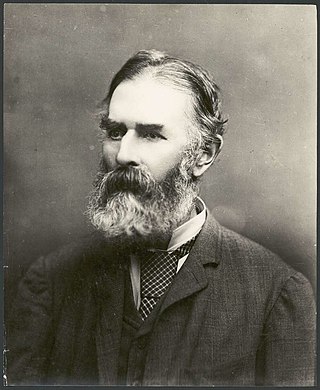
James Busby was the British Resident in New Zealand from 1833 to 1840. He was involved in drafting the 1835 Declaration of the Independence of New Zealand and the 1840 Treaty of Waitangi. As British Resident, he acted as New Zealand's first jurist and the "originator of law in Aotearoa", to whom New Zealand "owes almost all of its underlying jurisprudence". Busby is regarded as the "father" of the Australian wine industry, as he brought the first collection of vine stock from Spain and France to Australia.

John Farey Sr. was an English geologist and writer best known for Farey sequence, a mathematical construct that is named after him.

Lake Parramatta is a heritage-listed man-made reservoir and a recreational area located in North Parramatta, City of Parramatta, in the Western Sydney region of New South Wales, Australia. The masonry arch-walled dam across Hunts Creek was completed in 1856 to supply water for domestic purposes; and was operational until 1909. The dam has since been decommissioned and the lake and the surrounding nature reserve are a popular recreational area.

Busby is a suburb of Sydney, in the state of New South Wales, Australia. Busby is located 37 kilometres south-west of the Sydney central business district, in the local government area of the City of Liverpool. Neighbouring suburbs include Miller, Heckenberg, Hinchinbrook, Green Valley and Bonnyrigg.

"Building Vol. 23, No. 138 ". Trove. Retrieved 6 October 2022.
Charles Smith Wilkinson was an Australian geologist. He became geological surveyor in charge in New South Wales in 1875 and was president of the Royal Society of New South Wales in 1887.

George Murray Smith was a British publisher. He was the son of George Smith (1789–1846), who, with Alexander Elder (1790–1876), started the Victorian publishing firm of Smith, Elder & Co. in 1816. His brainchild, The Cornhill Magazine, was the premier fiction-carrying magazine of the 19th century.

Yan Yean Reservoir is the oldest water supply for the city of Melbourne, Victoria, Australia. At the time of its completion in 1857 it was the largest artificial reservoir in the world. It is 30 kilometres (19 mi) north of the city within the eponymous locality of Yan Yean, and is built on the Plenty River, a tributary of the Yarra River. An embankment 9.5 metres (31 ft) high holds back 30,000 ML (1.1 billion cu ft) of water.

Berambing is a rural locality in the Blue Mountains of New South Wales, Australia. The settlement is clustered around the Bells Line of Road, between Windsor and Lithgow, 10 kilometres (6.2 mi) west of Bilpin. It is situated across both the City of Hawkesbury and City of Blue Mountains local government areas. The settlement had a population of 106 people at the 2016 census.

Centennial Parklands is the name given to a group of three urban parklands located in the eastern suburbs of Sydney, New South Wales, Australia. Comprising approximately 360 hectares, the lands encompass Centennial Park, Moore Park and Queen's Park. The Parklands are listed on the New South Wales Heritage Register, with various components of national, state or local heritage significance. The parks are contained within the local government areas of City of Randwick, Waverley Municipal Council, and City of Sydney.

Henry Dangar was a surveyor and explorer of Australia in the early period of British colonisation. He became a successful pastoralist and businessman, and also served as a magistrate and politician. He was born on 18 November 1796 at St Neot, Cornwall, United Kingdom, and was the first of six brothers to emigrate as free settlers to New South Wales. From 1845 to 1851 Dangar was a Member of the New South Wales Legislative Council.
Thomas Woore was a Royal Navy officer, grazier, railways leader and surveyor. Woore was born in Derry, County Londonderry, Ireland and died in Double Bay, Sydney, New South Wales.
Alexander Grant McLean was a Surveyor General of New South Wales,.
William Christopher Bennett was an Irish born surveyor and engineer active in colonial Australia, Commissioner and Engineer-in-Chief for Roads and Bridges in New South Wales.

William Busby was an English-born Australian politician.

William John Dumaresq was an English-born military officer, civil engineer, landholder and early Australian politician. He is associated with settler colonisation of the areas around Scone and Armidale, in New South Wales.

Edward Orpen Moriarty (1824-1896) MA MInstCE was an Australian civil engineer, who undertook a number of important public works in New South Wales in the late nineteenth century.

The Woollahra Reservoir or WS022 is a heritage-listed underground reservoir at 5R Oxford Street, Centennial Park, City of Randwick, New South Wales, Australia. It was designed and built by the NSW Public Works Department. The property is owned by Sydney Water, an agency of the Government of New South Wales. It was added to the New South Wales State Heritage Register on 18 November 1999.

The Centennial Park Reservoir or WS001 is a heritage-listed underground reservoir at 3R Oxford Street, Centennial Park, City of Randwick, New South Wales, Australia. It was designed and built by NSW Public Works Department from 1896 to 1898. The property is owned by Sydney Water, an agency of the Government of New South Wales. It was added to the New South Wales State Heritage Register on 18 November 1999.

Rockwall is a heritage-listed house and former school at 7 Rockwall Crescent in the inner city Sydney suburb of Potts Point in the City of Sydney local government area of New South Wales, Australia. It was designed by John Verge and built from 1831 to 1837. It was added to the New South Wales State Heritage Register on 2 April 1999.














